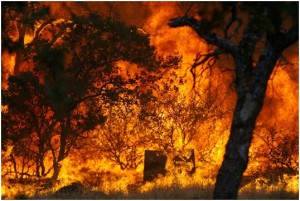By Lukas Nicholson
I worked my way through college as a fire fighter with the Forest Service. It was a dream job for me, for I worked outdoors and made good money during fire season. I learned a lot about fire behavior and its devastating effects on what is termed the ‘urban interface,’ where human development meets and intermingles with undeveloped wild land. Fires in these areas turned out to be the most dangerous, as they presented dangers from both wild land and structural fire-fighting.
These types of fires left the biggest impression on me compared to other fires. This wasn’t just because they were more dangerous, but because they involved working with the public and getting them to evacuate. It never ceased to amaze me how many people would be unprepared and unwilling to leave in the face of imminent danger to themselves and their property. This was the case even when the individuals had several hours to a day to prepare and evacuate.
Related: Protecting Your Home From Wildfires
Several hours may not sound like much time to gather your belongings and evacuate, but in many cases these individuals knew they were living in fire prone areas and should have prepared for such an eventuality, no matter how small the assumed risk. But it is not human nature to prepare ahead of time for a large scale disaster, especially if you’ve never experienced one before. Even if we watch it happen time and again on the news people in general typically won’t put much effort into getting prepared until the threat is imminent. Generally by that time they only escape with their lives and little else, if that.
But there is seldom an excuse for this sort of delayed response. Wildfires, hurricanes, and many other disasters often give you enough lead time to gather your necessary gear(which you should have prepped ahead of time) and get out safely. In the case of a threatening wildfire here is what you need to do.
- Have your bug out gear ready and be prepared to leave at a moment’s notice.
- Make arrangements beforehand to stay with a friend or relative outside the threatened area. Don’t travel far as you will want to return quickly should your home sustain damage.
- Keep your pets in one room where you can get to them should you have to evacuate.
- Keep your doors and windows shut to prevent smoke or burning embers from entering the home.
- Back your vehicle into the garage or driveway so you won’t have to back out.
- Listen to local radio stations for up to the minute emergency information, and pay close attention to any direction given by police or emergency personnel.
- Follow your instincts. If you feel you should leave but haven’t received official notification to do so, then leave. Waiting for direction from others may never come. Wildfires are unpredictable and can change direction, speed, and intensity without notice. A fire moving safely away from you one minute can suddenly change course, blow up, and become an imminent threat.
- If you leave the area, be cautious of emergency vehicles, fire trucks, and personnel on or along the roads. These vehicles may be moving fast, and with the smoke, you may not see them.
- Note the conditions of your escape routes. Don’t wait until the fire has cut off your escape routes to leave.
- It is not advisable to stay and try to save your house with a garden hose. Superheated air, enough to kill you instantly if you breath it in, can come hundreds of feet in advance of the flames.
Before leaving home make sure all your doors and windows are shut and locked. If you presently don’t have any sort of home alarm system, it may be worth considering, as empty communities make tempting targets. As soon as the authorities allow you to return home do so. This way you can quickly assess any damage and protect your home from further damage.
Lukas Nicholson has made his career in the home security industry. His interests lie in prepping for disasters of all kinds and sharing his knowledge through articles like this one.
This article was originally published at Ready Nutrition™ on September 15th, 2014







